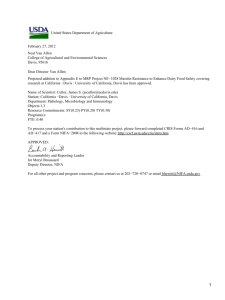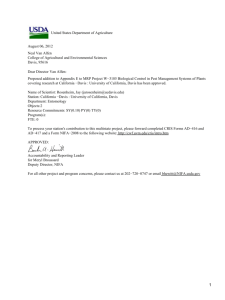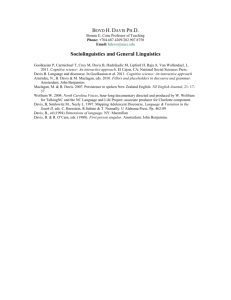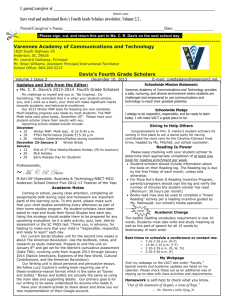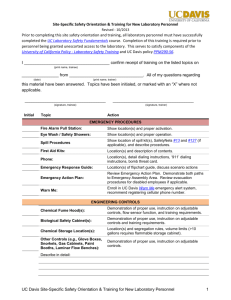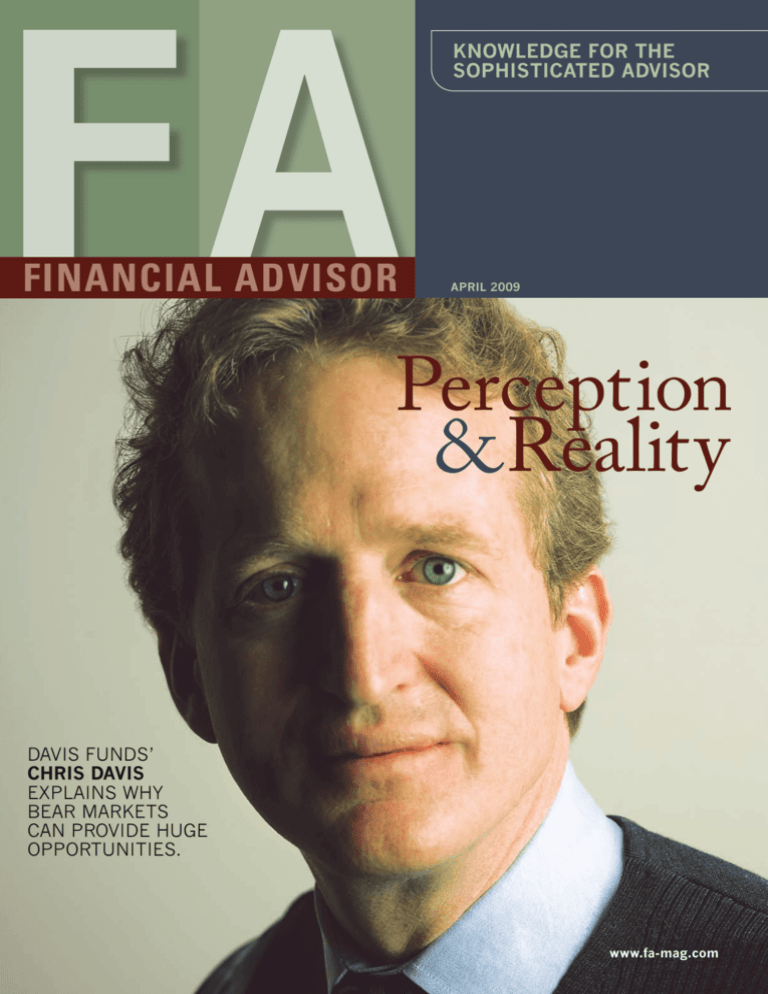
FA
financial advisor
KNOWLEDGE FOR THE
SOPHISTICATED ADVISOR
april 2009
Perception
& Reality
davis funds’
Chris Davis
explains why
bear markets
can provide huge
opportunities.
www.fa-mag.com
Perception
&reality
davis funds’ Chris Davis explains why bear markets
can provide huge opportunities. by evan simonoff
financial advisor magazine | april 2009
www.fa-mag.com
Cover Story
photographs by chad murray
april 2009 | financial advisor magazine
F
For much of his professional life, Chris Davis
found himself thinking, with a degree of jealousy, of stories
his father and grandfather would tell him about purchasing
shares in companies like Johnson & Johnson for 12 times
earnings with a 3.4% dividend back during the great bear
markets of the last fifty years.
Now that he could take advantage of a similar opportunity, it doesn’t feel like the incredible bargain basement it was
a half century ago. “The hardest thing is that every day the
market tells you you’re an idiot,” Davis says. “We’re nine years
into what will almost certainly become the worst decade for
stocks, including the 1930s (after the 20%-plus 1999 returns
is replaced with 2009).”
After learning about investing from his grandfather,
a former New York state insurance commissioner, diplomat
and an investor who parlayed $100,000 into $800 million1,
and his father, the legendary Shelby Davis, Chris Davis started in the business as an analyst in the middle of the 19821999 bull market in 1989. Until recently, he had never run
money in this kind of environment. “My grandfather used to
say you make most of your money in bear markets. You just
don’t realize it at the time,” Davis recalls.
Many investors like to buy great companies for the long
term, even if some are questioning that strategy today. But
finding an attractive entry point is critical to generating positive returns over a decade.
Pick a company like Johnson & Johnson or Procter & Gamble that is growing at 10% a year and paying a 3% dividend,
Davis says. “If you buy the stock at 10 times earnings and it
goes to a 15 P/E over a decade, that’s an 18% return,” he notes.
“If you buy it at 20 times earnings and the multiple goes to 15
over 10 years, your return is 6%.”
Davis isn’t about to call a bottom, something he considers a
“terrible thing to do.” People should be excited at the chance to
buy stocks on the cheap, but if they truly were, equity markets
would be a lot higher. At the same time, nobody has rung the
proverbial bell or published a magazine cover proclaiming “The
Death of Equities,” as Business Week did in 1979.
Davis notes that when the magazine ran that cover story, the
stock market had nearly doubled off its 1975 low, yet no one
felt very good about it. Interviewed in late February, he says it’s
been a long time since he heard “a single rosy forecast for the
next five or ten years.”
What is so pervasive today is the chasm between risk and the
perception of risk. Flying in airplanes in the pre-9/11 era was
much riskier than it is today. People just didn’t realize it.
Likewise, Davis observes that the safety of many small cars is
greater than SUVs, despite what SUV marketers may tell you.
“If a Toyota Camry collides with an SUV, you may have a better chance surviving in the SUV, but more people die in SUVs
than Camrys,” he continues. “People drive faster in the rain in
an SUV but they don’t brake any better.” If you really wanted
to reduce auto fatalities, he suggests putting a sharp steel spike
on the driver’s wheel.
The waves of selling triggered last fall by the collapse of Lehman Brothers struck him as irrational, as did the bull market
capitulation that afflicted some normally rational investors in
early 2000 when they stopped trying to fight the tidal wave and
piled into Cisco Systems at $80 a share. Six months ago, giant institutions found themselves locked in illiquid hedge-fund
and private-equity investments and some were forced to sell
their publicly traded, blue-chip stocks—at any price. “It was
pawnshop economics; sellers weren’t asking what the underlying businesses were worth,” Davis says. Fortunes, he continues,
are made at times like this when there is very little visibility.
Over the last ten years, the Standard & Poor’s 500 index has produced annual returns of between -2% and -3%,
depending on what day one measures. Can it do that for
another five or ten years?
“Possibly,” Davis acknowledges. “But if you look at every
ten-year period [when the S&P 500 return was below 5%]
and then look at the next ten years, the average annualized
return was about 13%, and the worst was 7%. The idea that
equities will underperform risk-free alternatives is a very low
probability. People are paying an irrational premium for the
perception of safety.”
Davis Advisors’ largest fund, the Davis New York Venture
Fund, has a reputation as having a strong interest in financial
shares. However, Davis explains their real objective is to find
growth companies in disguise, which often leads them to financial companies.
A classic example is Progressive Insurance, an auto insurer
that has grown at 18% to 20% for the last 20 years. “In almost
any other industry it would normally trade at 20 to 30 times
earnings, but Progressive trades at 12 times,” Davis says.
All financials are not the same, as Davis is quick to point
out. An investor who held a finance company, a retailer and a
capital goods concern might think they have the foundation of
a diversified portfolio, but if those companies happened to be
Countrywide, Home Depot and Toll Brothers they would have
been sadly disappointed in 2008.
In 2008, the Davis New York Venture Fund lost 40.0% of
1While
Shelby Cullom Davis’ success forms the basis of the Davis investment discipline, this was an extraordinary achievement and other
investors may not enjoy the same success.
financial advisor magazine | april 2009
www.fa-mag.com
Cover Story
its value, not far from the S&P 500’s 37% decline.2 But other
funds with excellent long-term track records, like Dodge &
Cox Stock Fund, fared much worse. Many gave back half their
NAV or more to the merciless market.
Davis’ funds take the long view and they are evaluated on
10-year performance figures. It so happens that the Davis New
York Venture Fund posted 10-year annualized total returns
of 1.24%, but beating the S&P 500, which fell 1.38% over 10
years, isn’t a source of satisfaction when returns are so low.
This equity market hasn’t spared any of the few winners,
and Davis is far too grounded in reality to take satisfaction
from outperforming some former superstars. “About 44% of
all managers in the top quartile over the last decade were in
the bottom decile for a three-year period,” he notes. In other
words, gloat at your own risk.
Despite their funds’ sizable setback last year, investors in
Davis’ funds managed to survive
the worst of the subprime tsunami
better than many others. Like survivors of a coal mine disaster, they
managed to live to fight another
day, while many rivals that saw
more than half their capital vaporized remain trapped below the
earth living off what oxygen rescuers can thread to them through
various tunnels.
Going into 2008, Davis and his
team knew that credit was too easy
and they assumed there would be
a downturn. Despite their financial exposure, they managed to
sidestep the first six victims—
Countrywide, Bear Stearns, Lehman, Fannie, Freddie and WaMu.
They weren’t so lucky with AIG,
once believed to be the strongest
financial services firm on earth. It
cost the fund a cumulative 6% over
the last five years. The fund also had
a long-term investment in Merrill
Lynch, which it had acquired at an
average cost of $35 a share. Right after its acquisition by Bank of America was announced at $29 a share,
the funds started selling. Say what
you will about former Merrill CEO
John Thain, but Davis notes he did “a
masterful job” at convincing Bank of
America to pay $29 a share.
The space on the wall between
Davis’ office and co-manager
Kenneth Feinberg is reserved for documenting their mistakes. In fact, it’s called The Mistake Wall.
In a ten-page letter to shareholders in February, the two
portfolio managers devoted nearly two pages to discussing
their AIG mistake, which cost investors three times more
than any other. “We owe our shareholders an accounting of
our mistakes,” Davis says.
Condensing their explanation, Davis and Feinberg conceded
that they—along with the entire AIG management team—
vastly underestimated the destructive potential of a certain derivative known as a credit default swap (CDS) and how much
collateral these contracts might require the insurer to post. Furthermore, they assumed that, since AIG was an insurance company, the classic run-on-the-bank scenario that brought down
Bear Stearns and Lehman was not a life-threatening danger.
But AIG had a big securities lending operation, and while they
2Performance
discussed in this article represents Class A shares, not including a sales charge as of 12/31/08, unless otherwise specified. Past
performance is not a guarantee of future results.
april 2009 | financial advisor magazine
had huge cash reserves, regulations did not allow them to upstream the cash from subsidiaries to the parent.
Perfect storms clearly possess higher odds than the vast majority of investors thought. “Nouriel Roubini was right and we
weren’t,” Davis says. “But the reaction that we should just raise
cash doesn’t make sense. It was like you are crazy if you don’t
own Cisco in 2000. Everyone wants to do today what they wish
they had done a year ago.”
Nonetheless, living through the last 18 months has, at
times, been a learning experience, even for sophisticated investors. The idea that a triple-A-rated company like General
Electric might have been unable to roll over its short debt and
saw its survival threatened stunned him. “We always assumed
credit would always be available to high-quality credits,” he
notes. This assumption, embedded in all of modern finance,
now needs to be revisited.
While Davis’ team members are meticulous students of accounting, they always viewed it as a way to provide different
takes on reality rather than something that directly impacts real-
public companies. Davis and his team expend a great deal of
effort trying to get at “the underlying reality,” examining such
adjustments as pension income/expense, depreciation versus
maintenance capital spending, nonrecurring charge-offs, inventory and mark-to-market adjustments, tax rates and the
cost of equity compensation.
Davis’ team likes to break their portfolio into four components. They label the first group camels, because these are
companies that can spend an eternity in the desert without
water, or rather capital. This list includes Procter & Gamble,
Costco and Microsoft.
Another holding in this category is Google. Davis watched
the company’s profits and shares soar in the years immediately
after its IPO. During that period, they also heard executives at
auto insurers like Progressive and Geico enthuse about the efficiency of using Google as an advertising vehicle. When Google
shares dropped more than 50% from their all-time high last
year and at less than 12 times their estimate of “owner earnings,” Davis’ team purchased it.
while davis’ team members are meticulous
students of accounting, they always viewed it
as a way to provide different takes on reality
rather than a way to directly impact reality.
ity. When rating agencies began to include equity prices, markto-market accounting and credit default swap spreads in their
calculations, the game changed. Now a downgrade can make a
company sell assets, even when there is no market for them. “Allowing the shameful explosion of the CDS market” as a place to
speculate on companies’ demise was a disgrace, Davis thinks.
Still, Davis, Feinberg and the rest of their portfolio management
and research staff dodged more bullets than many mutual funds—
for several reasons. As investors, they like to step back and look
at investments in ways that give them a degree of detachment to
avoid developing biases or getting locked into their convictions.
Speaking at a Morningstar conference several years ago,
Davis flashed a PowerPoint shot of some of the metrics they
consider important, then showed the numbers of two businesses that looked very similar. One happened to be a packaging
manufacturer, while the other was a railroad.
Scrambling various metrics might prove an interesting intellectual exercise, but what was the point? The point was that
numbers tell only part of the story, as CEOs have been heard
to quip that they can drive fleets of trucks through the holes in
generally accepted accounting principles.
Any advisor who owns his or her own firm knows that there
are legitimate ways to make their business look more or less
profitable, and those opportunities are magnified at huge
financial advisor magazine | april 2009
The second part of their portfolio centers on companies that
tend to be disciplined, opportunistic and well-positioned to
take advantage of sudden changes in the capital markets. Some
of these companies like Dun & Bradstreet and Loew’s Corp.
are also disciplined share repurchasers. Davis notes that in an
environment characterized by severe dislocations like those of
the last six months, many managements get scared and back off
stock buybacks at just the wrong moment.
The third group focuses on companies that operate in areas
where headline risk is the highest. Not surprisingly, this group
is heavy on financial services and includes Progressive Insurance
and Bank of New York Mellon, which is fundamentally more
of a transaction processor than a bank, as well as such franchise
financials as JP Morgan, Wells Fargo and American Express.
Straddling groups two and three is Berkshire Hathaway. “The
headlines on Berkshire are likely to get worse, but they went
into this crisis with $50 billion in cash and they are well-positioned to take advantage of this crisis,” Davis says. Recently, his
funds joined with Berkshire to invest in senior securities in two
companies whose equity they already own, Sealed Air and Harley Davidson. The securities yield 12% and 15%, respectively.
The final group revolves around companies positioned to benefit from the powerful emergence of a global middle class. “The
odds of China growing at 7% or 8% for the next decade are still
www.fa-mag.com
Cover Story
pretty high,” Davis says. Energy stocks like Occidental, ConocoPhillips, EOG and Devon dominate this group. Davis hasn’t
bought any oil service companies yet, “but we are looking.”
Does Davis worry about the rise of the anti-Wall Street,
pseudo-populist, anti-business environment in the wake of the
most severe collapse of the financial system in 80 years? Of
course. “People hear that and say, ‘I won’t invest,’” he says. “The
opportunity to invest comes about because of things like this.”
The odds are strong that taxes will be higher, inflation will
be higher, while productivity and profit margins will be lower.
Between 1975 and 1980, America experienced high unemployment, double-digit inflation and declining respect around
the world, but also in those years, stock prices nearly doubled
while small-cap stocks sparkled.
Looking into the next decade, Davis thinks it’s a “near certainty” the environment for equities will be superior to the
last decade. “The question isn’t what is going to happen; it’s
what is discounted,” he says.
The conventional wisdom that private equity funds and
hedge funds are the only logical buyers for toxic assets and other
opportunities that may arise from the crisis leaves him irked.
“Why doesn’t anyone ever mention public equity?” he asks.
Davis won’t draw a direct correlation between the headfirst
rush of institutional investors into alternative investments over
the last decade and the subpar returns so many of them experienced. But he is quick to note that the result was a move to less
liquidity, higher fees and more leverage, all of which reduced
returns and exacerbated the subprime debacle.
Ultimately, his firm’s goal is to create a portfolio that can
compound over a generation, a portfolio with offensive and defensive elements. He is also acutely aware that his shareholders
differ from those of hedge funds, as when his barber asked him
if he knew how many haircuts it would take him to recoup the
$1,000 he lost in Davis’ fund.
“What we do has life-changing consequences for our shareholders,” he reflects, noting that advisors deal with these issues
on a constant basis. “If you are wired with a stewardship gene,
you feel terrible right now.” Legal Disclosure:
Annualized Total Returns as of March 31, 2009
Davis New York Venture Fund Class A
with a maximum 4.75% sales charge
1 Year
5 Years
10 Years
–44.70%
–6.22%
–0.85%
The performance presented represents past performance and is not a guarantee of future results. Total return assumes reinvestment of dividends and capital gain distributions. Investment return and principal value will vary so that, when redeemed, an investor’s shares may be worth
more or less than their original cost. The total annual operating expense ratio for Class A shares as of the most recent prospectus was 0.85%. The
total annual operating expense ratio may vary in future years. Returns and expenses for other classes of shares will vary. Current performance
may be higher or lower than the performance quoted. For most recent month-end performance, visit davisfunds.com or call 800-279-0279.
This reprint is authorized for use by existing shareholders. A current Davis New York Venture Fund prospectus must accompany or precede this
reprint if it is distributed to prospective shareholders. You should carefully consider the Fund’s investment objectives, risks, charges and expenses
before investing. Read the prospectus carefully before you invest or send money.
DAVIS DISTRIBUTORS, LLC (DDLLC) paid Financial Advisor Magazine their customary licensing fee to reprint this article.
Financial Advisor Magazine is not affiliated with DDLLC, and DDLLC did not commission Financial Advisor Magazine to create
or publish this article.
This reprint includes candid statements and observations regarding investment strategies, individual securities, economic and market
conditions; however, there is no guarantee that these statements, opinions or forecasts will prove to be correct. These comments may
also include the expression of opinions that are speculative in nature and should not be relied on as statements of fact.
Davis New York Venture Fund’s investment objective is long-term growth of capital. There can be no assurance that the Fund will
achieve its objective. Davis New York Venture Fund invests primarily in equity securities issued by large companies with market
capitalizations of at least $10 billion. Some important risks of an investment in the Fund are: market risk: the market value of shares
of common stock can change rapidly and unpredictably; company risk: the market value of a common stock varies with the success
or failure of the company issuing the stock; financial services risk: investing a significant portion of assets in the financial services
sector may cause a fund to be more volatile as securities within the financial services sector are more prone to regulatory action in the
april 2009 | financial advisor magazine
financial services industry, more sensitive to interest rate fluctuations, and are the target of increased competition; and foreign country
risk: companies operating, incorporated, or principally traded in foreign countries may have more fluctuation as foreign economies
may not be as strong or diversified, foreign political systems may not be as stable, and foreign financial reporting standards may not be
as rigorous as they are in the United States. As of March 31, 2009, Davis New York Venture Fund had approximately 11.4% of assets
invested in foreign companies. See the prospectus for a complete listing of the principal risks.
The information provided in this reprint should not be considered a recommendation to buy, sell, or hold any particular security. As
of March 31, 2009, Davis New York Venture Fund had invested the following percentages of its assets in the companies listed: AIG,
0.07%; American Express, 2.05%; Bank of America, 0.08%; Bank of New York Mellon, 3.27%; Berkshire Hathaway, 4.83%; Cisco
Systems, 0.69%; ConocoPhillips, 2.84%; Costco Wholesale, 3.97%; Devon Energy, 2.70%; Dun & Bradstreet, 1.61%; EOG Resources,
2.64%; Google, 1.78%; Harley Davidson, 1.33%; Johnson & Johnson, 1.11%; JPMorgan Chase, 3.72%; Loews, 2.08%; Microsoft,
2.02%; Occidental Petroleum, 3.16%; Procter & Gamble, 1.73%; Progressive, 2.22%; Sealed Air, 2.01%; Wells Fargo, 2.79%.
Davis Funds has adopted a Portfolio Holdings Disclosure policy that governs the release of non-public portfolio holding information.
This policy is described in detail in the prospectus. Visit davisfunds.com or call 800-279-0279 for the most current public portfolio
holdings information.
This reprint is not a solicitation for the Dodge & Cox Stock Fund.
Broker-dealers and other financial intermediaries may charge Davis Advisors substantial fees for selling its products and providing
continuing support to clients and shareholders. For example, broker-dealers and other financial intermediaries may charge: sales
commissions; distribution and service fees; and record-keeping fees. In addition, payments or reimbursements may be requested
for: marketing support concerning Davis Advisors’ products; placement on a list of offered products; access to sales meetings, sales
representatives and management representatives; and participation in conferences or seminars, sales or training programs for invited
registered representatives and other employees, client and investor events and other dealer-sponsored events. Financial advisors should
not consider Davis Advisors’ payment(s) to a financial intermediary as a basis for recommending Davis Advisors.
A study is cited that examined the percentage of top quartile large cap equity managers whose performance fell into the bottom half,
quartile or decile for at least one rolling three-year period from January 1, 1999–December 31, 2008. 163 managers from eVestment
Alliance’s large cap universe whose 10 year average annualized performance ranked in the top quartile were examined. 97% fell into
the bottom half; 77% fell into the bottom quartile; and 44% fell into the bottom decile. The source is Davis Advisors. Past performance is not a guarantee of future results.
Over the last five years, the high and low turnover ratio for Davis New York Venture Fund was 16% and 3%, respectively.
The S&P 500® Index is an unmanaged index of 500 selected common stocks, most of which are listed on the New York Stock Exchange. The Index is adjusted for dividends, weighted towards stocks with large market capitalizations and represents approximately
two-thirds of the total market value of all domestic common stocks. Investments cannot be made directly in an index.
After July 31, 2009, this material must be accompanied by a supplement containing performance data for the most recent
quarter end.
Shares of the Davis Funds are not deposits or obligations of any bank, are not guaranteed by any bank, are not insured by the FDIC
or any other agency, and involve investment risks, including possible loss of the principal amount invested.
Item #5142 4/09 Davis Distributors, LLC, 2949 East Elvira Road, Suite 101, Tucson, AZ 85756, 800-279-0279, davisfunds.com
Opinions
and estimates contained in this article are subject to change without notice, as are statements of financial
market trends, which are based on current market conditions.
of
Financial Advisor Magazine. All
rights reserved.
This article originally appeared in the April 2009
Charter Financial Publishing Network, Inc.
issue




